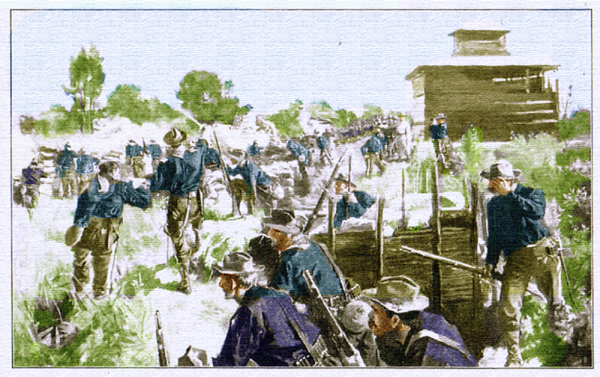
Advance Near Mandaloyan, 1899
In the above image American Volunteers are advancing on a blockhouse occupied by Filipinos. In 1897, Filipinos had
risen against the Spanish. The Spanish to protect Manila had contructed in a semi-circle of
trenches and fifteen blockhoses extending from the railroad north of the city to a point on
Manila Bay to the south. By February 8, 1899, the Filipinos had occupied all of the blockhouses and had constructed trenches facing the old Spanish
trenches. With the recapturing of San Roque, some of the Wyoming, Oregon,California, and Nebraska Volunteer were moved to the
old Spanish defensive line in the area of Mandaloyan. a sugar plantation. Nearby were the water works and
pumping station which served the City of Manila. However, at the time the Americans were in control of an area of only approximaely nine miles from
Manila. The Filipinos occupied the water works and
pumping station but for some reason had not cut water off to the City.
The Filipinos had also occupied some Roman Catholic churches where were used for firing down on
American troops. The First Wyoming was assigned to a line along the Pasig River. On February 5, Wyoming troops were able to drive the
Filipinos out of the church of San Pedro de Macati on the west bank of the Pasig River with, however, two Wyoming fatalities, Serg. George Rogers and Pvt. Ray F. Wiedman..
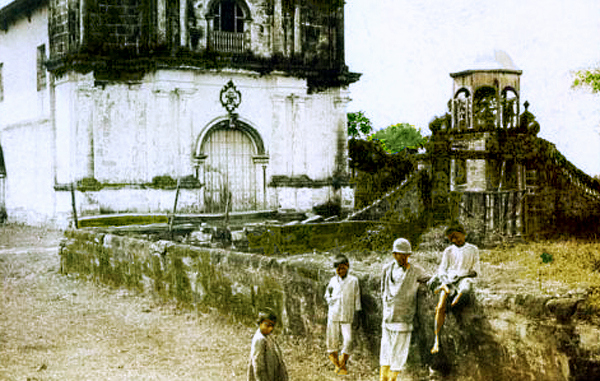
Children in front of the Church of San Pedro de Macati, 1899.
On the same date Wyoming troops participated in the Battle of Santa Ana which was particularly hard fought and were able to drived the Filipinos out of the
church and participated the the clearing of the area between the Waterworks and the Pumping Station in the center of the line.
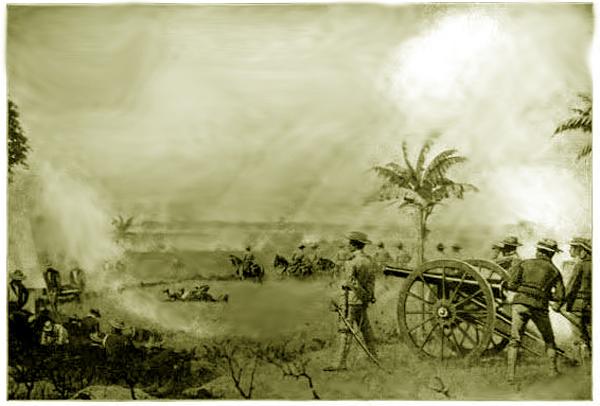
Battle of Santa Ana, Febuary 5, 1899. Image based on painting by Vasily Vaslyjevich Vareshchargin.
By February 23,1899, Insurgents and infiltrated the Tondo section of Manila. Some
60 buildings, 150 wooden buildings and 8,000 nipe (bamboo) structutes were
burned,
Wyoming troops remained in the vicinity of Mandaloyan until June 15 when they were moved to Zapote Bridge. The bridge, about seven miles from the center
of the City had been the scene on June 13, two days before, of the second largest battle during the "Philippine Insurection" as the new series of battles was later to be known. In the
Philippines it is known as the "Philippine-American War."
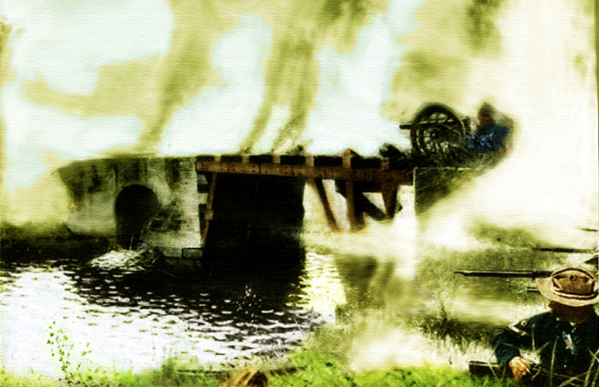
The Battle of Zapote Bridge, June 13, 1889. Image based on a sketch by Vasily Vaslyjevich Vareshchargin.
In the Philippines the battle
is referred to as the "Battle of Zapote River" to distinquish it from a battle fought by the
Filipinos against the Spanish two years before. The right hand span of the bridge was destroyed during that battle and as illustrated below a temporary
wooden span propped up by bamboo poles replaced the missing span.
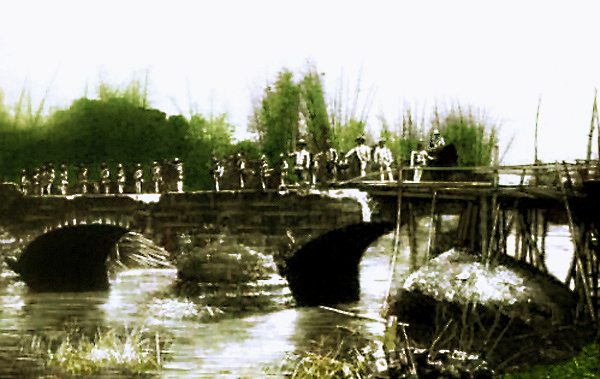
Spanish troops on the Zapote Bridge June 3, 1898, several days before the fall of
Manila to the Americans.
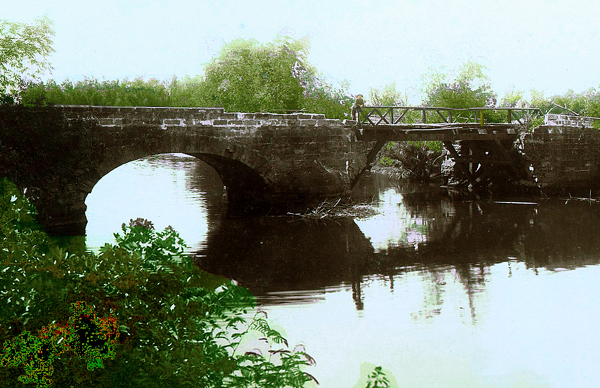
An American Solider standing on the Zapote Bridge following the Battle of Zapote Bridge and
temporary repair of the Bridge, 1899.
Superior American firepower defeated the Filipinos who retreated leaving a small unit to fight a rear guard action.
The rear guard then melted away in the bamboo thicket on the far side of the bridge.
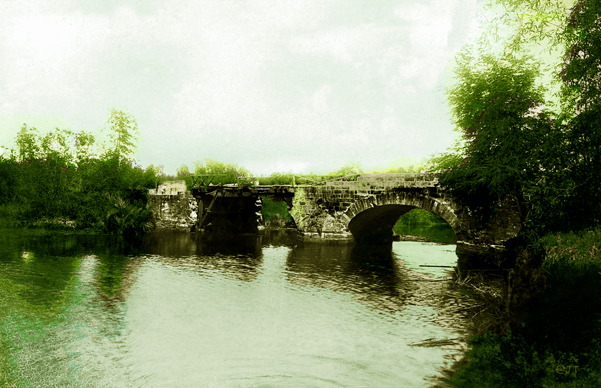
Zapote Bridge following the battle as viewed from the Insurents' position.
Vasily Vereshchagin (1842-1903) was a Russian artist who concentracted on depections of the horrors of war. He visited the Philippines in 1902-1903 and with
permission of General Arthur MacArthur depicted several scenes from the Philippine-Insurection. One of his most celebrated series of paintings exhibited at an
Art Show in Chicago was that of a
wounded American soldier in the hospital in Manila.
Music this Page:
Break The News To Mother
Words and Music by Charles K. Harris
As sung by Henry Burr
I.
While the shot and shell were screaming
upon the battlefield;
The boys in blue were fighting
their noble flag to shield;
Came a cry from their brave captain,
"Look, boys! our flag is down;
Who'll volunteer to save it from disgrace?"
"I will," a young voice shouted,
"I'll bing it back, or die;"
Then sprang into the thickest of the fray;
Saved the flag but gave his young life;
all for his country's sake.
They brought him back and softly heard him say:
[chorus]
Just break the news to mother,
She know how dear I love her,
And tell her not to wait for me,
For I'm not coming home;
Just say there is no other
Can take the place of mother;
Then kiss her dear, sweet lips for me,
And break the news to her."
II.
From afar a noted general
had witnessed this brave deed.
"Who saved our flag? speak up lads;
'twas noble, brave, indeed!"
There he lies, sir," said the captain,
"he's sinking very fast;"
Then slowly turned way to hide a tear.
The general in a moment,
knelt down beside the boy;
Then gave a cry that touch'd all hearts that day.
It's my son, my brave, young hero;
I thought you safe at home."
"Forgive me, father, for I ran away."
[repeat chorus]
"Break the News to Mother" was originally composed by Charles K. Harris (1867-1930" in 1892. With the outbreak of the
Spanish-American War, Harris re-wrote the lyrics and the song became a hit. The song was re-released with the advent of
World War I. The version heard in the background is from World War I. The popularity of the song made Harris's career. He was one of the founders of ASCAP. Because of the shortness of the
Spanish-American War most war songs of the era were reworked songs from the Civil War. After the war there were several songs such as "Old Fort Filepe, featured on the
next page, or "In Old Manila" whose themes were romantic memories of Manila.
Next page: Wyoming National Guard in the campaign south of Manila and return home.
Next page, Philippine Insurection Continued.
|